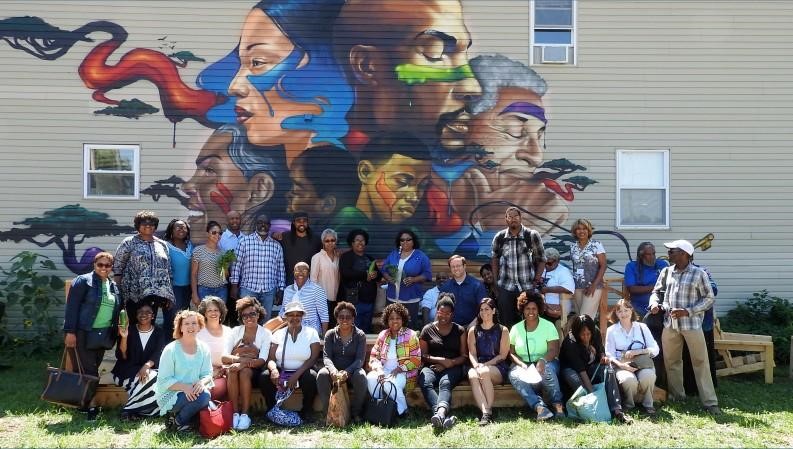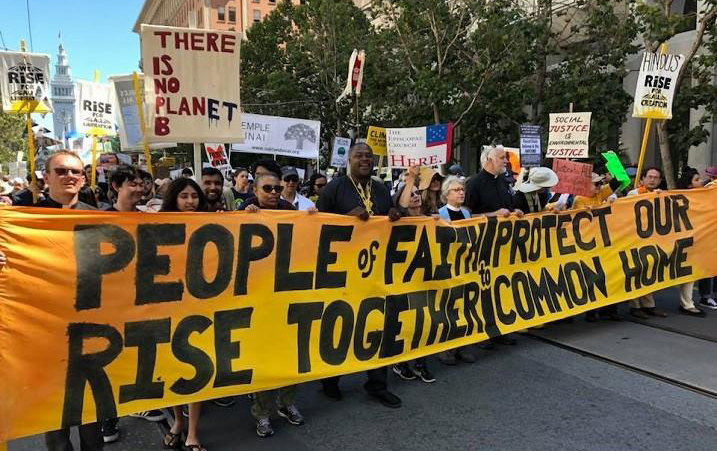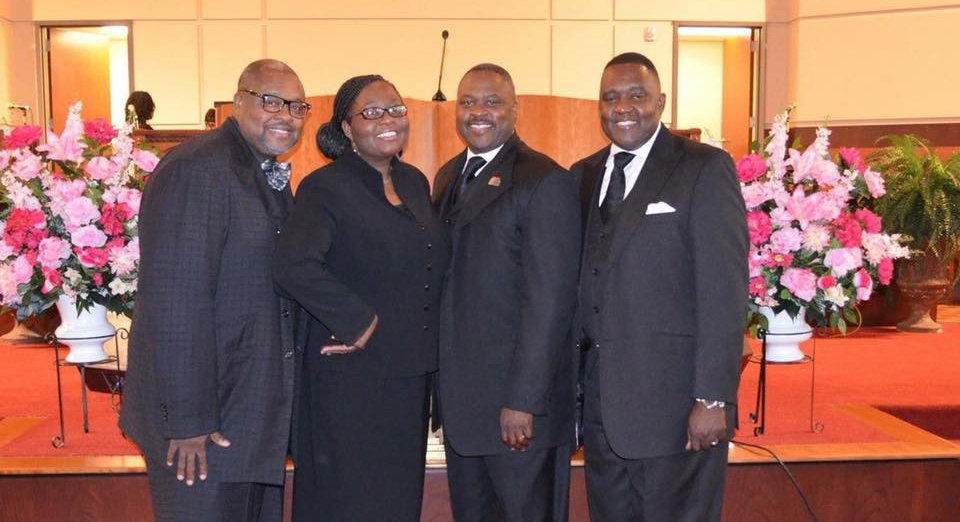July 21, 2020
A nonprofit works to ‘green’ the Black church

Green The Church encourages congregations to install solar panels, among other environmentally friendly strategies. Photos courtesy of Green The Church
Green The Church encourages African American congregations to commit to an environmental theology that promotes sustainable practices and helps build economic and political change.
As the son of an itinerant Baptist minister, Ambrose Carroll moved with his family from city to city as his father felt called to serve new churches: Atlanta, St. Louis, Compton, Santa Ana and finally, Oakland, California.
But there was one constant in the lives of the six Carroll siblings. Summers and holidays were spent back on the family homestead in the tiny community of Holly, Louisiana.
In that African American hamlet, 30 miles south of Shreveport, Carroll’s grandfather plowed the land, grew vegetables and raised livestock. It was a hardscrabble life — the family had no running water until 1979 — but it was rooted in conserving resources and caring for the Earth.
Years later, when Carroll began his own itinerant Baptist ministry, the memory of his family’s ecological roots tugged at him.
“Even though we grew up in the inner city and experienced blight and areas of disconnect, we grew up with a certain respect and reverence for the land,” he said.
In his own ministry — he now lives in Oakland, California, and pastors The Church by the Side of the Road in Berkeley — the Rev. Ambrose Carroll has made care for the Earth his signal calling.

Through his nonprofit organization Green The Church, he and his siblings, three of whom also are ministers, encourage African American congregations to commit to an environmental theology that promotes sustainable practices and helps build economic and political change.
With a small annual budget of about $150,000, the organization has helped some 1,000 churches consider taking small steps toward environmental healing, mostly through its annual summits and its continued work to build a core of advocates promoting green theology in African American congregations.
Environmental awareness has sometimes taken a back seat to other issues in Black communities, including economic and health care disparities, Carroll and others acknowledge. Those have been especially evident in the COVID-19 pandemic, which has affected African Americans in disproportionate numbers.
But pastors such as Carroll and a growing cadre of others point out that many racial disparities are rooted in environmental degradation, from exposure to lead paint and mold to an absence of nearby supermarkets — a phenomenon some have labeled “food apartheid.” National leaders such as the Rev. William J. Barber are supporters of the growing movement.
How might understanding the connection between racial disparities and environmental degradation inform your understanding of the Black Lives Matter movement?
Through its national summits (this year’s has been postponed to 2021 because of the pandemic), Green The Church is educating Black congregations about ways they can strengthen their communities by performing energy audits, installing solar panels, starting healthy food programs and lobbying for green jobs and investments in poor communities.
One way to do that is to connect to the African American experience.
“I got so tired of people saying, ‘African Americans don’t engage in nature or don’t appreciate the great outdoors,’” said Veronica Kyle, the statewide outreach director for Faith in Place, an Illinois-based interfaith organization that works on environmental stewardship and has partnered with Green The Church.
“No one ever talks about our bittersweet relationship with nature,” she said. “We have been both picking the fruit and strange fruit.”
Reconnecting African Americans with their personal and often traumatic history with the land lies at the heart of Carroll’s ministry, too. Often, he has found, those stories begin or end with the Great Migration that led some 6 million Black people to leave a life of sharecropping in the Jim Crow South for industrial jobs in the North, Midwest and West.
“Our ability to tell these stories is what I’m excited about,” said Carroll, 51. “The stories are here for us. We want to spend time building a repository of them.”

The pain of dislocation
Like many African Americans, Carroll himself has a story rooted in the pain of dislocation.
Before being called to the ministry, Carroll’s father, Benjamin Carroll Sr., was an agriculture major at Southern University and A&M College in Baton Rouge.
The elder Carroll planted gardens wherever the family lived, enriching their meals with homegrown vegetables. He kept a freezer stocked with beef or pork he bought through local farmers to avoid the industrial meat chain.
Using Isabel Wilkerson’s “The Warmth of Other Suns” as a resource, how might your organization fruitfully discuss the “pain of dislocation” with the land during and after the Great Migration?
One day, Ambrose Carroll remembered, his father walked through the door with live chickens.
But when the Carrolls left the South, they relocated to mostly poor, urban neighborhoods. By the time Ambrose was a teen, they were living in Oakland in the shadow of the Granny Goose potato chip factory.
Apart from summers back in Holly, Louisiana, the Carrolls had become city dwellers. It took a toll on their health. In 1983, Benjamin Carroll traveled to Memphis, Tennessee, to attend a National Baptist Convention and collapsed in the pulpit of First Baptist Church. He died at 44, having suffered a stroke. In later years, his wife, Ambrose’s mother, was treated for cancer. (She has since retired in Louisiana.)
Ambrose Carroll followed his father into the ministry, earning a master of divinity from the Interdenominational Theological Center’s Morehouse School of Religion in Atlanta, as had his father. It was there in the early 1990s that Carroll first heard about creation care, the theological approach that emphasizes the restoration and conservation of the Earth and its ecosystem as a central teaching of the Christian faith. Carroll believes that creation care can also reconnect Christian communities with the healing cultures of Native Americans and with humanity more broadly.
He returned to Oakland, was ordained in an American Baptist church, served in various churches and then completed a doctorate in ministry at United Theological Seminary in Dayton, Ohio.
“I learned much about liberation theology and the battle for justice,” Carroll said. “But I always wondered, what would be the issue of our day?”
He was aware of the growing use of the term “environmental racism.” The idea began to crystalize in the 1980s in recognition of how communities of color are disproportionately affected by government or corporate rules, regulations and policies that deliberately or through neglect expose Black people to environmental hazards.
Where are the well-paying green jobs in your community, and who holds these jobs? What kinds of training are required for access to this work? Could your organization help people obtain that training?
But what brought the issue home for Carroll was a book he picked up while serving a church in Denver, Colorado. The 2008 volume is called “The Green Collar Economy,” by former Obama administration adviser and now CNN political contributor Van Jones. In it, Jones argues for solving the ecological crisis in a way that lifts people out of poverty by creating well-paying green jobs in their communities.
Jones’ clear-eyed urgency about the ecological crisis is coupled with a conviction that a new green economy should provide equal opportunity and protect workers’ civil rights.
For the first time that Carroll could see, this was an attempt to bridge the divide between affluent, mostly white people who cared about saving polar bears and rainforests with working-class Black communities whose needs were far more immediate: living wages, good schools, a lower prison population.
“The language of environmentalism always seemed like something other,” Carroll said. “The book helped me to see it was not something we had to learn externally but internally, as a part of our identity.”
In taking up the cause of environmentalism, he would try to show his flock — then in Denver — how caring for the environment was part of their story, too.
‘The Black church needs its own voice’
It was at a meeting in Washington, D.C., in 2010 that Carroll’s vision grew.
Carroll had been accepted for a fellowship with Green For All, a training program started by Jones to cultivate leaders of color who could advocate for equitable green solutions in low-income communities. (Green For All has since merged with Dream Corps, an organization that works to close prisons.)
As part of his fellowship, Carroll met in the nation’s capital with a group of people strategizing how to bring environmental awareness to their communities.

Someone from West Virginia talked of “greening” the coal-mining community. A Native American man talked of “greening” the reservation. That’s when Carroll decided he would found an organization called “Green The Church.”
“When I was working with Green For All, there were a lot of people of color working on environmental issues, but there were not a lot of Black church leaders,” Carroll said. “The church is seen as conservative and not forward thinking.”
What was missing was clear, he said — “the Black church needs its own voice on the issue.” And he would provide it.

Green The Church, which was set up under the auspices of his family’s nonprofit, Carroll Ministries International, works with several state affiliate chapters to encourage church projects that strengthen the local food economy, plant community gardens, conduct energy audits and install rooftop solar panels and rainwater cisterns.
It now wants to move beyond its annual summits and start an online “ambassador’s course,” which will train 100 church members to help form “green teams” in local congregations and develop a core of 500 allies in those churches.
Already, it has seen some Black churches take bold green initiatives.
In Baltimore, the Rev. Heber Brown III has started the Black Church Food Security Network out of his Pleasant Hope Baptist Church. It works with Black farmers to deliver their bounty to the city’s hard-hit neighborhoods.
In Chicago, Trinity United Church of Christ has retrofitted its building to make it environmentally sustainable, and in 2017 the church dedicated the site of a 27-acre “green” intergenerational community called Imani Village.
The project already includes a medical center and will eventually offer affordable housing, a healing garden and a 5-acre farm.
The Rev. Dr. Otis Moss III, Trinity’s pastor, said he believes liberation is directly connected to creation care. As a result, the church has a commitment to awarding jobs to minority contractors who will hire the formerly incarcerated and commit to green practices.
Carroll’s own church has taken steps to change the culture. The Church by the Side of the Road offers water stations for Berkeley bikers. It composts, recycles, uses silverware instead of plastic utensils and serves lean, nutrient-rich foods at its congregational meals. It is transitioning away from printing programs and bulletins and is planning to build an herb garden. Photos of the natural world hang on the church walls.
The work of “greening” can be demanding, and making the case for the environment may be especially hard in the current context, as Black communities struggle with biased and violent policing and systemic racism.
“It’s a very tough area,” said the Rev. Gerald Durley, the national board chair of Interfaith Power & Light and a longtime Baptist pastor from Atlanta. “We have so many other priorities. But Ambrose is good at showing all of this is interconnected.”
Where is environmental degradation on your list of societal evils? Might it need to move up, especially as you work for racial justice?
Recently, the Rev. William J. Barber’s Poor People’s Campaign listed “ecological devastation” as one of the top societal evils behind its demands for change (alongside racism, poverty and militarism). Barber, one of the nation’s foremost civil rights leaders, sees the threat of climate change as one of the main injustices affecting the nation’s poor.
Sharing the stories of connection and dislocation
One way to break through, Carroll is convinced, is to engage with people’s own personal stories.
“Ambrose has recognized the need to culturalize the conversation so it would have more impact in the African American community,” said Kyle, the Chicago-based activist with Faith in Place.
By “culturalize,” Kyle means to make the conversation relevant to an American Black context, a strategy that has also worked with her Migration & Me program, which encourages African Americans to share their migration stories — often out in nature.
What stories can you share that root your faith, experiences or ancestors in the land? How can you share them so that they become formative?
Moss said he also tries to make these connections.
“I share with people, ‘Your grandmother had a garden in the back. Your grandmother made quilts, which is a form of recycling. Our ancestors created gumbo, which is a creative use of things people thought could not be used,’” he said.
“When you explain those pieces, people are like, ‘Oh yes. We came from Mississippi and Arkansas. We were people connected to the land and to the soil, and coming into an urban environment disconnected us from the soil.’ We’re seeing a reemergence of people reconnected to the soil in Northern urban environments.”
Carroll doesn’t flinch from the pain of those stories. He has often spoken of how his ancestors bought their land in 1878, only to lose it during the period following Reconstruction when they became sharecroppers tilling other people’s land.
Still, his ancestors’ legacy of good stewardship, thrift and hard work was part of the inheritance they passed down to their descendants.
Carroll hopes that in time, other African Americans might see their stories as part of a longer narrative about care for the Earth.
“The more you tell the story,” Carroll said, “the more others can come alongside you.”
Questions to consider
Questions to consider
- Ambrose Carroll and others point out that many racial disparities are rooted in environmental degradation. How might this history inform your understanding of the Black Lives Matter movement?
- Using Isabel Wilkerson’s “The Warmth of Other Suns” as a resource, how might your organization fruitfully discuss the “pain of dislocation” with the land during and after the Great Migration?
- Where are what Van Jones calls the “well-paying green jobs” in your community? Who holds these jobs? What kinds of training are required for access to this work? Could your organization help people obtain that training?
- The Rev. William J. Barber’s Poor People’s Campaign lists “ecological devastation” as one of the top societal evils fueling its demands for change. Where is the environment on your list? Might it need to move up, especially as you work for racial justice?
- Carroll teaches Black churchgoers that caring for the environment is “part of their story, too.” What stories can you or your organization share that root your faith, experiences or ancestors in the land? How can you share them so that they become formative?
